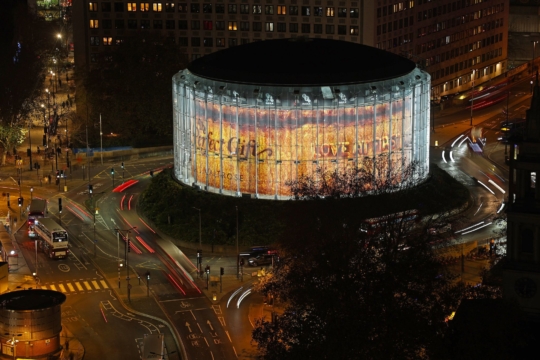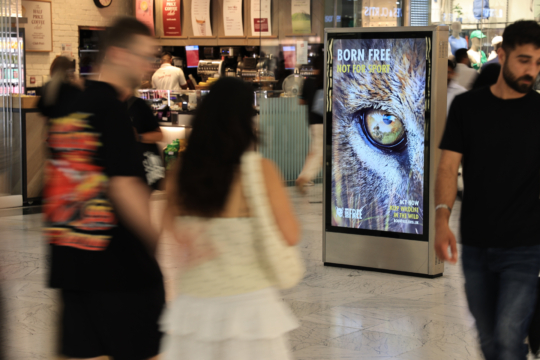New research demonstrates a step change in the evolution of DOOH
Socially amplified DOOH content delivers uplift in brand approach and engagement
Exclusive neuroscience research released today (Tuesday, March 21) by Ocean establishes how premium digital out of home (DOOH) primes and optimises social media campaigns, elevating brand relevance, likeability and authenticity.
Building on a decade of work with Neuro-Insight, Ocean’s fifth neuroscience study uses brain imaging to demonstrate how premium DOOH is a vital ingredient in helping brands extract better value from their social media content.
To test the hypothesis that premium DOOH and social media channels are congruent and innately aligned, Ocean analysed brain responses to different forms of social media posts which had been shared across Tik Tok and Instagram.
Two cohorts of participants in London and Manchester were shown advertising content from brand social media posts, social media posts shared by well-known influencers within that brand’s sector and DOOH content featuring the brand.
Significantly, the participants were also shown social media posts which featured the DOOH content itself in order to gauge the relative brain response to each form of content.
From the resulting responses, Neuro-Insight concluded that:
- Ten years after Ocean’s first neuroscience study, despite the rapidly evolving media landscape, the priming effect of premium DOOH has not changed, but is in fact reaffirmed.
- DOOH primes social media content positively. People are drawn further to brands on social media when they have seen the brand campaign on DOOH first, delivering a tangible priming impact from the DOOH in terms of brand approach (+87% in London), emotional response (+5% in Manchester) and dwell time (+1.3x in Manchester).
- Viewing the same piece of premium DOOH content on a physical screen first and then seeing that DOOH screen amplified socially strengthens brand perception and elevates attention levels. The London cohort recorded a 28% uplift in approach and a 13% increase in engagement when compared to a non-DOOH primed brand post.
- Socially amplified DOOH content shared by brands strengthens brand familiarity and relevance and celebrity influencers strengthen excitement and authenticity.
- Those shown the socially amplified DOOH content, but not the physical execution, registered a 21% increase in approach and a 3% increase in emotional intensity (Manchester), compared to a 79% increase in approach in London and a 5% increase in emotional intensity.
Ocean Outdoor UK CEO Phil Hall said the study demonstrates a step change in the evolution of DOOH.
“Put simply, if a brand has a social media strategy on the plan then it needs to build in DOOH to make it better and more effective,” he said.
“Neuroscience has previously established the priming effect of premium DOOH on mobile devices. Now we can demonstrate what happens when out of home transcends the physical screen and becomes the content for brands’ social media campaigns.
“Using DOOH content across social media unlocks significant value, delivering well beyond the priming effect of physical DOOH alone. For advertisers these are serious benefits, proving DOOH is a vital ingredient when used to make big statements and mark important moments which by their very nature are incredibly shareable.”
Hypothesis
Building on four previous neuroscience studies, the hypothesis was that that full motion DOOH advertising creates enhanced emotional associations for advertisers when used as part of their social media campaigns, thus strengthening the impact of memory encoding on the brain.
Methodology
Neuro-research was chosen as the way of exploring impact, because it provides a means of looking at people’s sub-conscious responses which are difficult to assess through traditional, questions-based research. Neuro-Insight, a pioneer in neuromarketing and neuroanalytics, conducted the research.
The study was conducted in London and Manchester to collect responses which were representative of both cities’ innate cultural differences. A sample of 138 participants took part in the study, attending a central facility and wearing headsets that recorded their brain responses.
For the social media platforms, Tik Tok and Instagram were chosen for their scale, the visual nature of the content they support and their reach across the 16 to 34-year-old demographic.
The London cohort was exposed to DOOH led social content which has appeared on the Piccadilly Lights. Manchester was used as a proxy for Ocean’s wider DOOH assets. Both cohorts have different levels of exposure to OOH ads and different views on social networks which the findings of this study reflects.
Neuro-Insight owns a patented brain mapping technology called SST, which allows them to measure physiological measures such as long term memory and approach on a second-by-second basis as people interact with their social media.
The technology records and measures electrical signals at the scalp in order to build a second by second picture of activity in the brain. All metrics used are based on measures that have been published and peer reviewed and are well-established in the field of neuroscience.
For all of our neuroscience studies, please visit https://oceanoutdoor.com/neuroscience/








